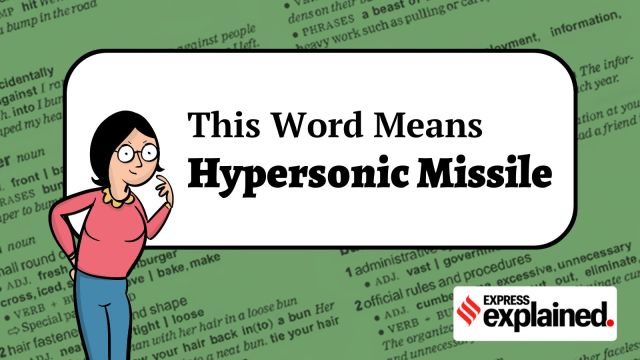This Word Means: Hypersonic Missile
Every day, 500 words on a word (or expression) that has appeared in The Indian Express
 Hypersonic missiles travel at a speed Mach 5, or at least five times the speed of sound in the upper atmosphere.
Hypersonic missiles travel at a speed Mach 5, or at least five times the speed of sound in the upper atmosphere.WHY NOW?
Russian President Vladimir Putin last week launched Perm, a nuclear-powered submarine with hypersonic Zircon missiles. Perm is the first of its kind to be equipped with Zircon (also spelled Tsirkon) missiles as a standard feature.
According to the Russian news agency TASS, Putin described its launch as a “milestone event” for the Russian navy.
WHAT ARE HYPERSONIC MISSILES?
Hypersonic missiles travel at a speed Mach 5, or at least five times the speed of sound in the upper atmosphere. However, the main feature of a hypersonic missile is its maneuvrability, meaning its trajectory can be altered according to the intended target.
These are generally slower than intercontinental ballistic missiles.
WHY ARE HYPERSONIC MISSILES FORMIDABLE?
For one, hypersonic weapons can potentially evade missile shields and early warning systems. According to a 2021 Congressional report, ground-based radars or terrestrial radars cannot detect hypersonic missiles until late in the flight of the weapon. This makes it difficult for the responders to the missile attack to try to intercept the missile and assess their options.
Former Commander of US Strategic Command General John Hyten said that hypersonic weapons can enable responsive, long-range strike options against distant, defended or time-critical threats (such as road-mobile missiles) when other forces are unavailable, denied access or not preferred.
Conventional hypersonic weapons use only kinetic energy, energy derived from motion, to destroy unhardened targets or even underground facilities.
WHAT ARE THE DIFFERENT TYPES OF HYPERSONIC MISSILES?
The two types of hypersonic weapons systems are Hypersonic Glide Vehicles (HGVs) and Hypersonic Cruise Missiles (HCMs). HGVs are launched from a rocket before gliding to the intended target, while HCMs are powered by air-breathing high-speed engines or ‘scramjets’ after acquiring their target.
WHAT TO KNOW ABOUT ZIRCON
According to Russia, the Zircon can reach eight times the speed of sound, has a range of 625 miles and can carry a 660-pound warhead.
If this is accurate, the Missile Defense Advocacy Alliance, a US-based nonprofit,told the New York Times that Zircon would be one of the fastest in the world, “making it nearly impossible to defend against due to its speed alone.”
HAS ZIRCON BEEN USED BEFORE?
According to Ukraine, yes. Ukraine’s Kyiv Scientific Research Institute of Forensic Expertise claimed that Russia had deployed Zircon missiles in attacks on several cities last February, based on weapon debris found in Kyiv.
ABOUT THE PERM SUBMARINE
A Kremlin press release describes the Perm as a fourth-generation multipurpose nuclear-powered submarine, and the sixth in a series of Yasen-class submarines.
The Perm will become the first nuclear-powered submarine in this class to carry Zircon missiles.
“Yasen-M-class submarines are equipped with modern navigation, communication and hydroacoustic systems. They carry high-precision weapons and are fitted with robotic equipment,” Putin said at the launch event.
- 01
- 02
- 03
- 04
- 05






































